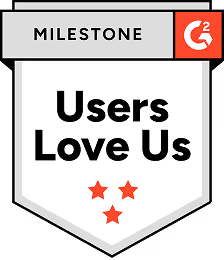AI in Business Examples: 7 Artificial Intelligence Use Cases

“Nobody phrases it this way,” Sebastian Thrun, former Google VP and current CEO of Kittyhawk Corporation said, “I think that artificial intelligence is almost a humanities discipline. It's really an attempt to understand human intelligence and human cognition.”
AI has had a hockey-stick shaped growth in attention over the last six months after the public release of ChatGPT. While OpenAI’s interface introduced one of the easiest ways a layperson could interact with artificial intelligence, AI has been changing businesses for years now.
If you still think AI is “a ways off” from affecting businesses, we’re going to dive into seven ways that AI can help augment and improve your business today.
But first, let’s set the stage.
Why is AI all over the news
Talking about AI these days can get polarized quickly. On one side you have the “they’re going to replace [insert job here]” camp and on the other you have “Hey look, I used AI to rewrite my grocery list in the voice of Samuel L. Jackson”.
While the latter is undoubtedly fun (you should try it), the former concern can’t and shouldn’t be overlooked, the truth is somewhere in the middle. This was exactly what a study conducted by OpenAI and the University of Pennsylvania hoped to figure out.
“Using job data from the US Department of Labor,” Yahoo Finance reported, “the researchers found that up to 80% of the US labor force could see "at least 10% of their work tasks affected" by GPT language models and that 19% of workers "may see at least 50% of their tasks impacted.’”
The key word there is impacted. It doesn’t necessarily mean that AI is going to eliminate jobs but will affect how we accomplish our day-to-day tasks, and in many ways, open up even more opportunities for humans.
15 years after losing to IBM’s AI, Deep Blue, Chess Grandmaster Garry Kasparov observed that the future was going to be augmented by computers. “Human strategic guidance,” he said in an Op-Ed, “combined with the tactical acuity of a computer was overwhelming.”
7 examples of using Artificial Intelligence in Business
Kasparov noted that a “Weak human + machine + better process was superior to a strong computer alone and, more remarkably, superior to a strong human + machine + inferior process.”
Today’s efforts to digitize are often held back by inferior processes. AI can help update those processes and help your business grow faster to respond to changing conditions.
1. Connecting older systems
Older organizations are often dealing with legacy applications or systems that can’t be sunset because they contain must-have information or workflows necessary to continue to operate the business.
Unfortunately, many of these systems are hopelessly out of date by today's standards and may not even be able to integrate properly with current tech stacks. This can leave that data or process siloed and hard to integrate into your overall workflows.
AI applications can help with either extracting the necessary information from those legacy systems or even recode older software in order to support the more modern technological infrastructure.
2. Responding to customer requests
Consumer expectations for customer service have drastically changed in the last few years. According to Live Agent, “40% of consumers expect a response within the first hour, while 79% expect an answer in the first 24 hours.”
Depending on the size and breadth of your organization, this can make managing headcount and timezones a nightmare.
Today’s conversational AI solutions like the one offered by our friends at Drift can allow you to have an “always on” customer assistant to respond. That way, you can resolve customer queries or set up time for them to speak with a live support agent, driving higher customer satisfaction and brand loyalty.
3. Automating tedious, manual tasks
While everyone thought we’d be in a glorious, paperless era by now the truth is more complicated.
Some departments within organizations are still forced to process paper invoices. The costs of having to manually deal with each and every paper invoice can add up as Adobe estimates that it can cost anywhere from $15 to $40.
When you start getting into the hundreds of invoices in a single month, if even a fraction of those need to be processed manually you could be looking at thousands of dollars per month. OCR has improved exponentially with platforms like Google’s reaching accuracy rates as high as 98%.
Less manual work leads to more accurate data which can be a huge boon for organizations as poor data quality costs them as much as $15MM annually according to Gartner.
4. Spotting trends in huge data sets
Humans are already great at spotting patterns and to, as C8 sciences puts it, “not only find patterns but figure out in a logical way what those patterns suggest about what will happen next.”
In the age of Big Data though, spotting patterns in data lakes is about as easy as spotting a particular rock at the bottom of an actual lake.
AI isn’t held back by these limitations. Current Machine Learning algorithms leverage Deep Learning to mimic how we learn. The more a particular AI is trained on a data set, the better it gets at spotting anomalies or pulling out trends and insights.
This can make business activities such as measuring business performance, customer behavior analysis, and forecasting various scenarios far quicker and easier than trying to do it manually with spreadsheets and a tad of gumption.
5. Personalized Messaging
The “spray and pray” tactics of marketing in years past no longer work. Your audiences will ignore you or worse, unsubscribe/block you on that channel. It’s become so much more important to research and craft messages that resonate with your audience.
Unfortunately, this sort of research takes time and practice to get it down to a repeatable format.
AI platforms (like Regie.ai) can shortcut the time and skill required to truly personalize at scale by helping you write that first draft within seconds or minutes, not hours. Our Deep Learning model continually takes input from performant data and your own CMS content to generate more targeted messages that get your prospects' attention and drive results.
6. Building competitive analyses
Keeping an eye on your competitors' activities is just as crucial as selling your own product/service, to achieve sales success. As competitive intelligence platform Crayon observed in a study, “If someone on your sales team is working six deals right now? Chances are four of them are competitive—at least.”
Many AI tools including Microsoft’s Bing can scrape the internet for publicly available information. This can shortcut your time to research competitors down to a fraction of what it used to be.
More advanced AI tools can even build your own custom CMS where you can train the AI on exactly how you speak about your own product allowing you to compare and contrast solutions and use that information to build battlecards, write emails, or win a competitive deal.
7. Identifying efficient revenue generation channels
Between email, LinkedIn, PPC, organic social, online and offline events, there are too many channels to count for businesses these days (and we didn’t even list half of them).
Trying to cover every single possible place is not only inadvisable, it’s likely impossible when budgets get tighter. A majority of marketers predicted that they would either have the same or less budget going into 2023 and we’ve seen that hold true as teams are told their four favorite words: “do more with less”.
Instead of guessing which channels are working, you can use AI platforms to dig into closed-won data and reverse engineer which channels lead to those deals.
From there, you’ll be able to determine which channels are most efficient in spending and simply focus your efforts there.
Closing thoughts
The impact AI is having on businesses becomes more evident day by day and will only continue to grow.
That doesn’t mean that you shouldn’t start leveraging the opportunities it offers now.
From connecting systems to responding efficiently and personalizing customer messages, AI and its algorithm-based features have proven their worth time and time again.
No matter the size, industry, or range of services your company provides, taking steps now towards utilizing AI technology is essential for staying competitive.
Knowing where or how to start with AI can be daunting but we’ve published a guide to get a complete understanding of how Generative AI is modernizing sales teams and processes today.
FAQs
Read more posts
View all BlogsNeed more help?
If you still have questions, make sure to check out our Help Center: there, you'll find all the tips & advice you'll need to get your team up & running with Regie.ai.









